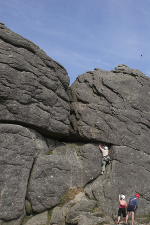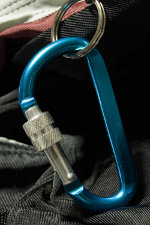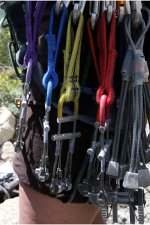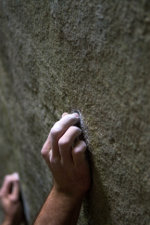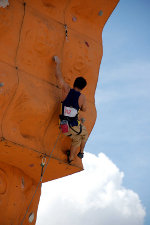Aid Climbing – Still the most popular method of climbing big walls. Progress is accomplished by repeatedly placing and weighting gear which is used directly to aid ascent and enhance safety.
Free climbing – The most commonly used method to ascend climbs refers to climbs where the climber’s own physical strength and skill are relied on to accomplish the climb. Free climbing may rely on top rope belay systems, or on lead climbing to establish protection and the belay stations. Anchors, ropes and protection are used to back up the climber and are passive as opposed to active ascending aids. Subtypes of free climbing are trad climbing and sport climbing. Free climbing is generally done as “clean lead” meaning no pitons or pins are used as protection.[2]
Traditional climbing – Traditional or Trad Climbing involves rock climbing routes in which protection against falls is placed by the climber while ascending. Gear is used to protect against falls but not to aid the ascent directly.
Sport Climbing – Unlike Traditional Rock Climbing, Sport Climbing involves the use of protection (bolts) or permanent anchors which are attached to the rock walls.
Bouldering – Climbing on short, low routes without the use of the safety rope that is typical of most other styles. Protection, if used at all, typically consists of a cushioned bouldering pad below the route and/or a spotter, a person who watches from below and directs the fall of the climber away from hazardous areas. Bouldering may be an arena for intense and relatively safe competition, resulting in exceptionally high difficulty standards.
Free soloing (not to be confused with free climbing) is single-person climbing without the use of any rope or protection system whatsoever. If a fall occurs and the climber is not over water (as in the case of deep water soloing), the climber is likely to be killed or seriously injured. Though technically similar to bouldering, free solo climbing typically refers to routes that are far taller and/or far more lethal than bouldering. The term “highball” is used to refer to climbing on the boundary between soloing and bouldering, where what is usually climbed as a boulder problem may be high enough for a fall to cause serious injury and hence could also be considered to be a free solo.
Indoor climbing – Permits climbing in all types of weather and at all times of day. Used for improving climbing skills and techniques.
Deep Water Soloing – Similar to free soloing in that the climber is unprotected and without a rope, but different in that if the climber falls, it is into deep water instead of on to the ground.
Rope soloing – Solo climbing with a rope secured at the beginning of the climb allowing a climber to self-belay as they advance. Once the pitch is completed the soloist must descend the rope to retrieve their gear, and then reclimb the pitch. This form of climbing can be conducted free or as a form of aid climbing.
Simul climbing – When two climbers move at the same time. The pseudo-lead climber places gear that the pseudo-follower collects. When the leader runs low on gear they construct a belay station where the follower can join them to exchange gear. The stronger climber is often the pseudo-follower since a fall by the follower would pull the leader from below towards the last piece of gear—a potential devastating fall for the leader. In contrast, a fall from the leader would pull the follower from above, resulting in a less serious fall. Most speed ascents involve some form of simul climbing but may also include sections of standard free climbing and the use of placed gear for advancement (i.e. partial aid or pulling on gear).
Top roping – Climbing with the protection of a rope that’s already suspended through an anchor (or also known as a “Top Rope System”) at the top of a route. A belayer controls the rope, keeping it taut and preventing long falls. Most Indoor climbing or “gym climbing” is top roping on indoor purpose-made climbing walls although it is also common to boulder and sport climb indoors. Gym climbing is used as training for outside climbing, but some climb indoors exclusively. Due to its reduced risk, most beginners are introduced to climbing through top-roping.
